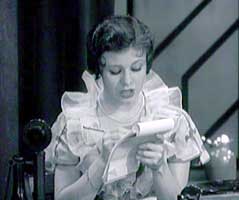 The one-reel musical Office Blues (1930) regards Miss Gravis (Ginger Rogers), a secretarial typist with a crush on the boss. She sings "(I Can See Where) We Can't Get Along," with such witty lyrics as "I am cynical, he's rabbinical.," in a grand flapper style.
The one-reel musical Office Blues (1930) regards Miss Gravis (Ginger Rogers), a secretarial typist with a crush on the boss. She sings "(I Can See Where) We Can't Get Along," with such witty lyrics as "I am cynical, he's rabbinical.," in a grand flapper style.
Greg (E. R. Rogers; must've been a cousin of Ginger's, he has no other film credits) is another office worker, one who has a crush on Miss Gravis, though she persists in her desire for the boss Jimmy Ross (Clairborne Bryson). The character of Greg steps out of the picture never having contributed much.
Ginger's second number is is "Dear Sir" about being "just another cog" in a crappy job. But to the boss she feels like doing a secretarial transcription that begins, "Dear Sir, I am waiting for you."
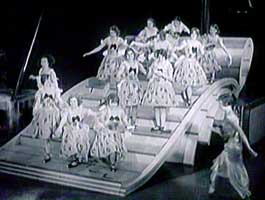 Unexpectedly the film goes into a fantasy sequence of tiny-tiny secretaries (who are the Maria Gambarelli Dancers) performing on a steno pad atop the office desk. Unexpectedly the film goes into a fantasy sequence of tiny-tiny secretaries (who are the Maria Gambarelli Dancers) performing on a steno pad atop the office desk.
Jimmy eventually sings with his secretary though the guy's not such a hot singer compared to Ginger, & the actor playing him must be another relative who never did anything else. As the little film ends, it turns out the boss does want to make a little hay with her.
The two songs were written by Vernon Duke & E.Y. Harburg, who as a team wrote such hits as "April in Paris," with Harburg also the lyricist for "Over the Rainbow" & other great songs from Wizard of Oz (1939).
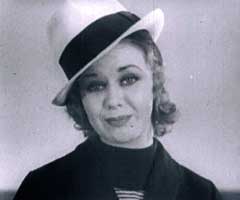 Ginger also makes appears in a the wee film Hollywood Hit Parade #1: Used to Be You (1932) which as I write this isn't cited in either of the two major film indices on line, as it was created as an ephemeral film that by luck survives. Ginger also makes appears in a the wee film Hollywood Hit Parade #1: Used to Be You (1932) which as I write this isn't cited in either of the two major film indices on line, as it was created as an ephemeral film that by luck survives.
Before there were jukebox "soundies" there were already three-minute musical routines sometimes called "Studio Snapshots," or "Screen Snapshots," including Hollywood Hit Parade #1, apparently filmed the same time as a twelve minute "snapshots" films of numerous stars called Hollywood on Parade (1932) & another one-reeler Hollywood Hit Parade #2 (1932) with Ginger just one of an impressive line-up that includes Louis Armstrong, Al Jolsen, & James Cagney.
Ginger Rogers sings a song she wrote herself, "The Gal Who Used to be You," which she dedicates peculiarly enough to comic actor Jack Oakie, who performs with her partially in drag. It's a cute little number because Ginger's so cute, & nice to see she was so talented she could even write her own songs if given the opportunity.
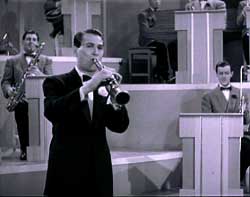 Artie Shaw's Class in Swing (1939) features Artie & his swing band, with a dashing young Buddy Rich on drums.
Artie Shaw's Class in Swing (1939) features Artie & his swing band, with a dashing young Buddy Rich on drums.
Behind the opening credits we hear the spooky "Nightmare" which would be the perfect, absolutely perfect opening tune for a film noir.
The orchestra is magically materialized & put together section by section before our very eyes, as the narrator's instructional lecture on what a band requires proceeds. A bit of a tune called "Table d'Hote" written by Artie but not elsewhere recorded. Rhythm section appears first, Artie pops into existence second, then a sax session appears, & finally a brass section.
The resultant materialized band is "swing that's really in the groove," with Artie on clarinet, playing "Table d'Hote" written by Artie but not elsewhere recorded by him, followed by another instrumental "Free Wheeling."
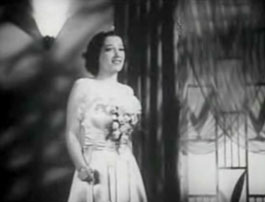 Ellen Forrest comes in for the vocal on "I Have Eyes," with the opening verse "I have eyes to see with, but they see only you/ For you have eyes that put the very stars to shame/ I have lips to sigh with, what else am I to do/ when you have lips that fill my very soul with flame." The arrangement is unique to this film, a bit slower than in the 78 rpm release. Ellen Forrest comes in for the vocal on "I Have Eyes," with the opening verse "I have eyes to see with, but they see only you/ For you have eyes that put the very stars to shame/ I have lips to sigh with, what else am I to do/ when you have lips that fill my very soul with flame." The arrangement is unique to this film, a bit slower than in the 78 rpm release.
"I have Eyes" was written by Leo Robin & Ralph Rainger, very popular song writers whose many well remembered tunes included the Oscar-winning "Thanks for the Memories" which became Bob Hope's themesong. Bing Crosby also sang "I Have Eyes" the same year in Paris Honeymoon (1939).
Helen Forrest had big shoes to fill when Artie hired her, for she was replacing Billie Holiday. No one's really Billie's equal, but Helen was no slouch. She did not stay with Artie long, however, scarcely two years, moving on to the Benny Goodman orchestra shortly after this little film was made. In the '40s she would record with Harry James, Nat King Cole, Lionel Hempton, & similar greats. She was still singing into the early 1980s.
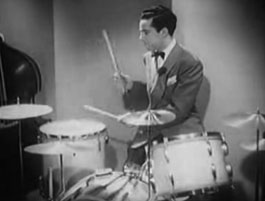 There's an intrusive voice-over here & there on the film. This is apparently the voice of Bill Goodwynn, narrating a text that must've embarrassed Artie, alleging that none of this jazz is written down but that great musicians always improvise as they go along. There's an intrusive voice-over here & there on the film. This is apparently the voice of Bill Goodwynn, narrating a text that must've embarrassed Artie, alleging that none of this jazz is written down but that great musicians always improvise as they go along.
The perfectly harmonized horn section in particular denies the narrator's insistance that "it's all impromptu."
The notion they're all just winging it is even more nonsensical than the early scenes of bandmembers materializing by magic. But can't blame the band for the narrator or his silly script.
The orchestra closes with Artie's composition "Shoot the Likker to Me John-Boy," a nice piece of hopping swing jazz with some notable solos woven in, mostly Artie's clarnet but also a fun trombone solo by Harry Rodgers, & lots of Buddy's amazing drumming.
Although the "class room" narrator again gets in the way of the aural quality, we get to hear most of it uninterupted.
This one-reel musical short would've been a lot better without the intrusions of the unseen, anonymous professor, but Artie comes through as nevertheless pretty damned great.
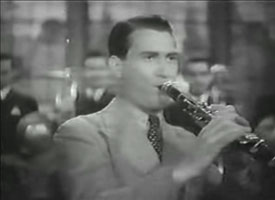 Behind the opening credits for Symphony of Swing (1939), Artie Shaw can be seen playing his licorice stick.
Behind the opening credits for Symphony of Swing (1939), Artie Shaw can be seen playing his licorice stick.
The titles fade from the screen & there he is in close-up, his orchestra behind him, performing a slow-swing instrumental of the Howard Diez/Arthur Schwartz song "Alone Together."
The camera receeds. revealing the entire band in front of a fancy three-part window which is seen in several Vitaphone one-reelers. Buddy Rich is seated highest in the back at his drum kit.
The scene slowly shifts to a surreal arrangement of the band flanking Artie in darkness, pianist at white piano at back of stage. The band is shown serially in different attitudes & seating or standing arrangements, lots of visual variety, which gives away teh fact that it's a mimed performance, likely recorded earlier in the day.
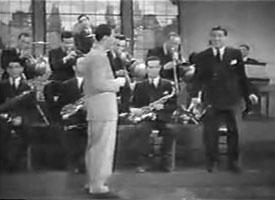 Perhaps unintended, the mood of the shifting scenes of the band adrift in nothingness is rather eerie. The number closes back in front of the three-part window, almost exactly at the three-minute mark. Perhaps unintended, the mood of the shifting scenes of the band adrift in nothingness is rather eerie. The number closes back in front of the three-part window, almost exactly at the three-minute mark.
Artie briefly addresses the audience: "And now a little tune with a vocal choras by Tony Pastor." This one will be perfor4med entirely in front of the tripartate window, with no fancy edits, about a minute & three-quarters in length.
Predominantly an instrumental, they begin to play a jaunty arrangement of "Jeepers Creepers," a song that my fave when I was about six or seven years old, & which got me slapped across the face by an evil guardian who snapped, "Stop singing that!"
The Artie Shaw arrangement on this number is nothing special, but it's great fun when Tony Pastor stands up & begins to sing. He was a fine sax player who would eventually leave Artie's band to start his own successful orchestra. His vocal form seems a little influenced by Jack Teagarden, rough & lovely, an ideal voice for this number.
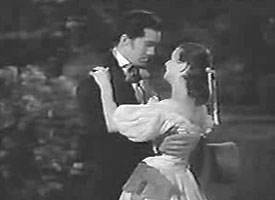 As soon as "Jeepers Creepers" is finished, Artie turns back to us, the audience, & says, "Presenting Miss Helen Forrest singing "Deep Purple" composed by Mitchell Parish & Peter Derose. As soon as "Jeepers Creepers" is finished, Artie turns back to us, the audience, & says, "Presenting Miss Helen Forrest singing "Deep Purple" composed by Mitchell Parish & Peter Derose.
The band strikes up the tune, & Helen in long gown saunters out & sings the gorgeous slow-dance romantic tune:
"When the deep purple falls/ Over sleep garden walls/ And the stars begin to flicker in the sky/ Will the mist of the memory/ You wander back to me/ Breathing my name with sigh..."
The scene shifted almost immediately to a nighted garden. An old woman trudges into the garden & sits on a bench, overwhelmed by "the mist of the memory." A handsome yong man appears as though a ghost & takes off his tophat to the old woman, who is overcome with emotion over this image of the love of her lost youth.
Suddenly she springs from the bench & is transformed into a young woman with Victorian gown. The lovers cling as Helen continues to sing on the soundtrack. At length her beau looks at his pocket-watch & vanishes in midstep from the garden.
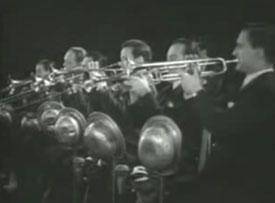 The young woman slowly fades away. The old lady remains seated in the deep purple haze of the dream. A scant minute & a half of romantic fantasy! The young woman slowly fades away. The old lady remains seated in the deep purple haze of the dream. A scant minute & a half of romantic fantasy!
Visually this one-reel film comes full circle for the Gershwin brothers' "Oh, Lady Be Good," which begins in front of the fancy window, then repeats the drifting-in-space images of the band members flanking Artie, as already seen in the opening instrumental, continuing the spooky atmosphere from the ghostly garden in the previous number.
The instrumentation for the full orchestra is excellent, with beautiful solo for Artie on clarinet, a lead alto sax solo by Hank Freeman, and a couple others. With Bob Kitsis at that white piano shining in the back, & Artie in a white suit, they are almost ghostly in the utter darkness surrounding them.
The scene then partially fades into dance club with jitterbugs cutting not the rug but a checkerboard linoleon, overlaid on the orchestra, eradicating the spooky element of the film. In overlaid images we get a piano solo, a portrait of Buddy Rich at his drums, & other double-exposure band member portraits. What a treat!
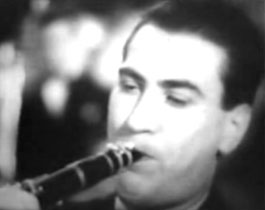 A Warner Brothers Vitaphone one-reel musical short, Artie Shaw & His Orchestra (1939) has the band playing "Nightmare" behind the opening credits, which is also used behind the opening credits of the Paramount musical short that same year, Class in Swing.
A Warner Brothers Vitaphone one-reel musical short, Artie Shaw & His Orchestra (1939) has the band playing "Nightmare" behind the opening credits, which is also used behind the opening credits of the Paramount musical short that same year, Class in Swing.
The band soon appears on screen with Artie close-up in the foreground, playing out "Nightmare" to its end.
Then Artie immediately says, "And now ladies & gentlemen, our own version of Cole Porter's 'Begin the Beguine.'" The absolutely lovely arrangement highlight's Artie's clarinet. Tony Pastor gets a great lead sax moment.
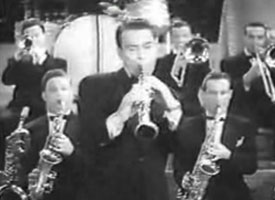 He next introduces "one of the season's best ballads," Helen Forrest singing "Let's Stop the Clock." It's lyrically pretty darned good, & musically a slow-dance delight. He next introduces "one of the season's best ballads," Helen Forrest singing "Let's Stop the Clock." It's lyrically pretty darned good, & musically a slow-dance delight.
It was written by J. Fred Coots & Haven Gillespie (whose best known song was to be "Santa Claus is Coming to Town"). Helen sings:
"Let's stop the clock, & make believe this night of love will never end/ This is our chance, don't pass it by/ Ohh, let's stop the clock, & capture eveyr thrill this night of love may send/ This is romance, don't let it die, darling..."
"And now one of our own compositions," says Artie, & the band strikes up "Nonstop Flight." It's a bouncy sweet thing that even tots could dance to, like stuff Kay Kyser's Musical College might've played.
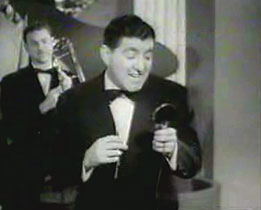 "For our next number we present Tony Pastor on a little Russian tune, 'Pross Tchai.'" The number is actually by Saul Chaplin & Sammy Cahn who often took inspiration from folk music & turned it into swing jazz. "For our next number we present Tony Pastor on a little Russian tune, 'Pross Tchai.'" The number is actually by Saul Chaplin & Sammy Cahn who often took inspiration from folk music & turned it into swing jazz.
Tony sings into a hand-held microphone: "Here's an ancient Russian story/ That sings of love in all its glory/ It's called pross tchai which means goodbye goodbye, don't cry, I'll soon be returning to you..."
Tony's voice hasn't yet gotten rough-edged as it would be in the following decade. His range is higher & brighter than when he got his own orchestra, & he has so much life & charm.
In all, a nice wee film. White bands better than Artie's are hard to name, & I can't help but feel a lot of it is because he hung out in Harlem learning how. Though unimaginative in its cinematography & badly faded with poor preservation, the film is nevertheless quite thrilling because the band's so grand.
copyright © by Paghat the Ratgirl
|
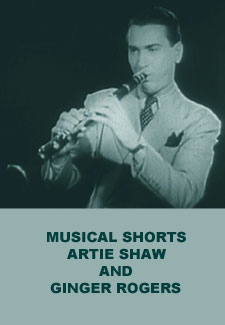

 Unexpectedly the film goes into a fantasy sequence of tiny-tiny secretaries (who are the Maria Gambarelli Dancers) performing on a steno pad atop the office desk.
Unexpectedly the film goes into a fantasy sequence of tiny-tiny secretaries (who are the Maria Gambarelli Dancers) performing on a steno pad atop the office desk. Ginger also makes appears in a the wee film Hollywood Hit Parade #1: Used to Be You (1932) which as I write this isn't cited in either of the two major film indices on line, as it was created as an ephemeral film that by luck survives.
Ginger also makes appears in a the wee film Hollywood Hit Parade #1: Used to Be You (1932) which as I write this isn't cited in either of the two major film indices on line, as it was created as an ephemeral film that by luck survives.
 Ellen Forrest comes in for the vocal on "I Have Eyes," with the opening verse "I have eyes to see with, but they see only you/ For you have eyes that put the very stars to shame/ I have lips to sigh with, what else am I to do/ when you have lips that fill my very soul with flame." The arrangement is unique to this film, a bit slower than in the 78 rpm release.
Ellen Forrest comes in for the vocal on "I Have Eyes," with the opening verse "I have eyes to see with, but they see only you/ For you have eyes that put the very stars to shame/ I have lips to sigh with, what else am I to do/ when you have lips that fill my very soul with flame." The arrangement is unique to this film, a bit slower than in the 78 rpm release. There's an intrusive voice-over here & there on the film. This is apparently the voice of Bill Goodwynn, narrating a text that must've embarrassed Artie, alleging that none of this jazz is written down but that great musicians always improvise as they go along.
There's an intrusive voice-over here & there on the film. This is apparently the voice of Bill Goodwynn, narrating a text that must've embarrassed Artie, alleging that none of this jazz is written down but that great musicians always improvise as they go along.
 Perhaps unintended, the mood of the shifting scenes of the band adrift in nothingness is rather eerie. The number closes back in front of the three-part window, almost exactly at the three-minute mark.
Perhaps unintended, the mood of the shifting scenes of the band adrift in nothingness is rather eerie. The number closes back in front of the three-part window, almost exactly at the three-minute mark. As soon as "Jeepers Creepers" is finished, Artie turns back to us, the audience, & says, "Presenting Miss Helen Forrest singing "Deep Purple" composed by Mitchell Parish & Peter Derose.
As soon as "Jeepers Creepers" is finished, Artie turns back to us, the audience, & says, "Presenting Miss Helen Forrest singing "Deep Purple" composed by Mitchell Parish & Peter Derose. The young woman slowly fades away. The old lady remains seated in the deep purple haze of the dream. A scant minute & a half of romantic fantasy!
The young woman slowly fades away. The old lady remains seated in the deep purple haze of the dream. A scant minute & a half of romantic fantasy!
 He next introduces "one of the season's best ballads," Helen Forrest singing "Let's Stop the Clock." It's lyrically pretty darned good, & musically a slow-dance delight.
He next introduces "one of the season's best ballads," Helen Forrest singing "Let's Stop the Clock." It's lyrically pretty darned good, & musically a slow-dance delight. "For our next number we present Tony Pastor on a little Russian tune, 'Pross Tchai.'" The number is actually by Saul Chaplin & Sammy Cahn who often took inspiration from folk music & turned it into swing jazz.
"For our next number we present Tony Pastor on a little Russian tune, 'Pross Tchai.'" The number is actually by Saul Chaplin & Sammy Cahn who often took inspiration from folk music & turned it into swing jazz.